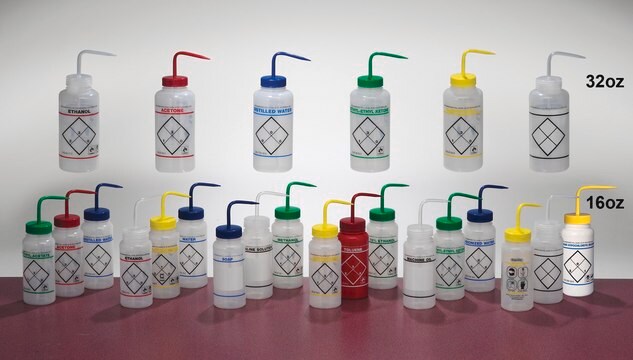425044
Hypochlorite de sodium solution
reagent grade, available chlorine 10-15 %
About This Item
Produits recommandés
Qualité
reagent grade
Niveau de qualité
Agence
suitable for SM 4500 - NH3
Pression de vapeur
23.3 hPa ( 20 °C)
Forme
liquid
Composition
available chlorine, 10-15%
Pertinence de la réaction
reagent type: oxidant
Caractéristiques du produit alternatif plus écologique
Safer Solvents and Auxiliaries
Learn more about the Principles of Green Chemistry.
sustainability
Greener Alternative Product
Concentration
10-15% (chlorine by Na2S2O3, titration)
Point d'ébullition
111 °C
Densité
1.206 g/mL at 25 °C
Autre catégorie plus écologique
Température de stockage
2-8°C
Chaîne SMILES
[Na+].[O-]Cl
InChI
1S/ClO.Na/c1-2;/q-1;+1
Clé InChI
SUKJFIGYRHOWBL-UHFFFAOYSA-N
Vous recherchez des produits similaires ? Visite Guide de comparaison des produits
Description générale
Application
Towards greener solvents for the bleach oxidation of alcohols catalysed by stable N-oxy radicals
Clause de non-responsabilité
Mention d'avertissement
Danger
Mentions de danger
Classification des risques
Aquatic Acute 1 - Aquatic Chronic 2 - Eye Dam. 1 - Met. Corr. 1 - Skin Corr. 1B
Risques supp
Code de la classe de stockage
8B - Non-combustible corrosive hazardous materials
Classe de danger pour l'eau (WGK)
WGK 2
Point d'éclair (°F)
Not applicable
Point d'éclair (°C)
Not applicable
Certificats d'analyse (COA)
Recherchez un Certificats d'analyse (COA) en saisissant le numéro de lot du produit. Les numéros de lot figurent sur l'étiquette du produit après les mots "Lot" ou "Batch".
Déjà en possession de ce produit ?
Retrouvez la documentation relative aux produits que vous avez récemment achetés dans la Bibliothèque de documents.
Protocoles
Cell culture protocol for proper aseptic technique to maintain a sterile environment and to prevent cell culture contamination. Free ECACC handbook download.
Notre équipe de scientifiques dispose d'une expérience dans tous les secteurs de la recherche, notamment en sciences de la vie, science des matériaux, synthèse chimique, chromatographie, analyse et dans de nombreux autres domaines..
Contacter notre Service technique






